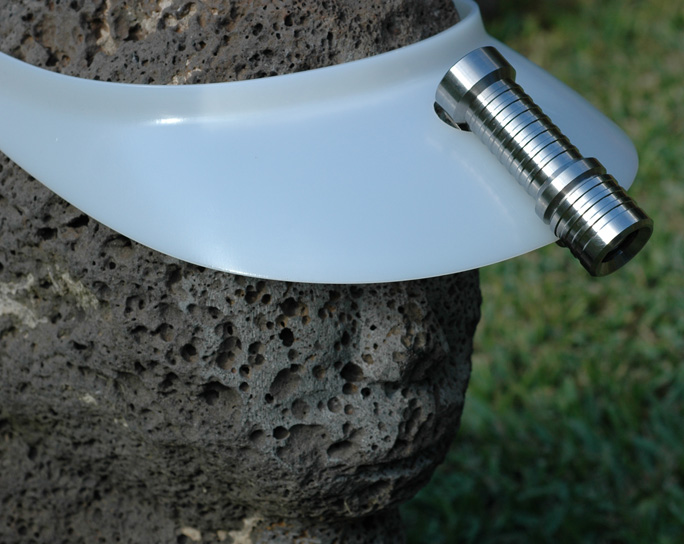
I have been working with a new Nichia 083 LED that has been designed with special phosphors to provide a high CRI or color rendering index. I have used the LED's in a few different flashlights and fixed lighting fixtures which may be mentioned below. The primary focus though is on a titanium "SunDrop" flashlight which I designed specifically with this LED in mind.


The 083 LED has 6 small dice on it and it is not a stellar performer in terms of flux or lumen output when compared to contemporary high power LED's. I believe this LED is best suited for flood applications with even distribution of intensity. Because the output is not way up there, I elected to have a sapphire lens made which condenses the output in a tighter and brighter flood spot as compared to the case with no secondary optics.


For comparison of the lens (seen in two shots above) VS no optics, I paired a SunDrop prototype against an Aleph Mule hosting the the same type 083HighCRI LE:

I placed the two lights very close to a white wall:


Now that most of my illumination at home is via LED sources, I have discovered in some instances, the lack of red in the typical LED leads to poor color rendition which can be problematic. Primarily it makes for skin tone perception and meat preparation while cooking difficult. I have solved this problem by including some red LED's in certain areas and I have found that the Nichia 083 High CRI LED itself is excellent for portable light sources where you need to distinguish colors on a more natural basis.
CRI is based on tungsten black body sources and it is misleading to use this standard with LED's but it serves some purposes and worthy of consideration.
Below is a spectrum comparison between one sample of the Nichia and a Cree XR-E LED:
You can see where the blue spike of the Nichia is much less in amplitude compared to the Cree and there is a greater band of more even distribution in the higher wave lengths.
Below is a sampling of noon day sunshine compared to a SunDrop prototype. I adjusted the sampling period on the SunDrop to scale its peak to match that of the sun sampling:
I have no confidence in tight accuracy and calibration of my integrating sphere but I believe the comparisons hold in a rough and relative manner at least. The ultimate proof is in the eye of the beholder and I have truly noticed a difference when using a high CRI LED compared to a more typical LED in cases where colors were viewed in a less than casual manner.
Needed to make sure the SunDrop could get wet:





To see how the SunDrop fares as a camera light, I clipped it to an adjustable arm clamped to the tripod holding a Nikon D70. The first shot below was taken of the camera set up and subject with an Olympus 1030 Stylus and using built in flash:

The photo below was taken with the Stylus, hand held and no flash. It gives an idea of the beam coverage of the SunDrop:

Below is the picture from the Nikon with no adjustments to the image at all beyond re sizing:

The beam of the SunDrop seems well suited for hands free tasks close at hand but does require some directing. This light inspired me to follow through with an idea I have had for some time now. I have a few head lamps and use them when the need arises. Instead of going to the effort of a head lamp with the SunDrop front end, I went with the simple HatLamp idea:



and as a similar approach, a visor lamp:

A simple 3/4" hole in the bill allows the clip to pass through and secure the light very well. Adjusting the pitch of the bill coupled with the wide beam angle of the SunDrop makes this combo quite effective. An aluminum bill or possibly a thermally conductive fabric of carbon could be used to enhance thermal dissipation if deemed necessary.
Below, a SunDrop XP (extended play) which uses a SOB buck converter and 2xCR123 pak:

Runtime on the "XP" using two SureFire CR123 batteries:

There are times when you need good illumination close at hand to allow you to see some small wonders.
